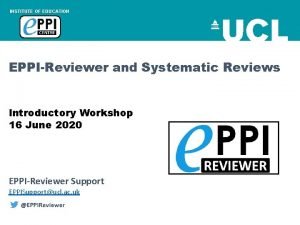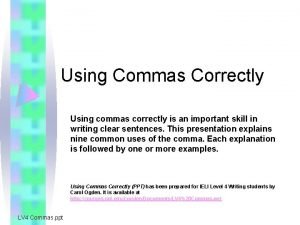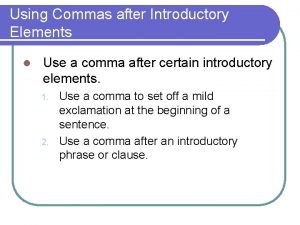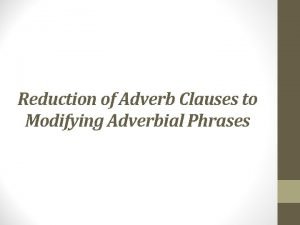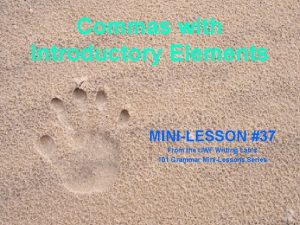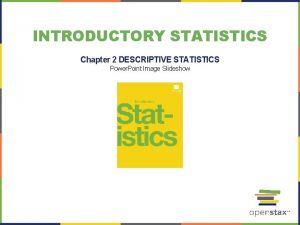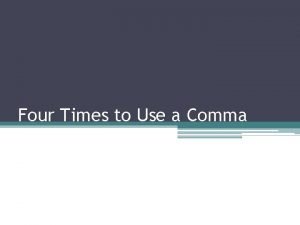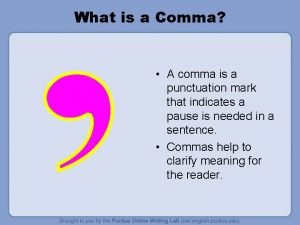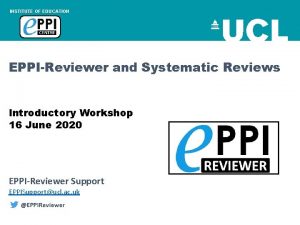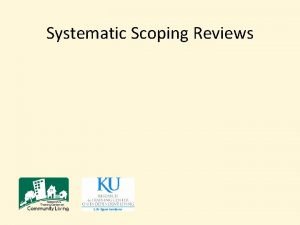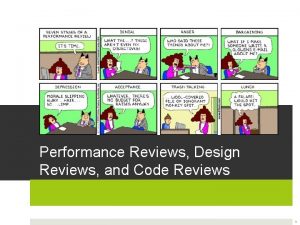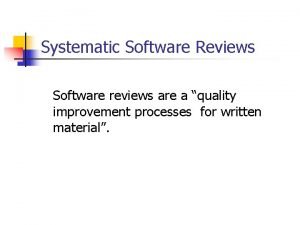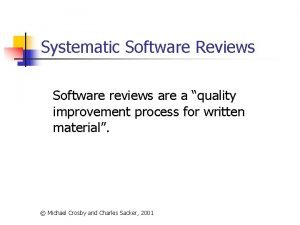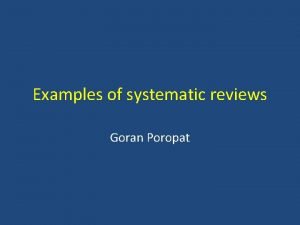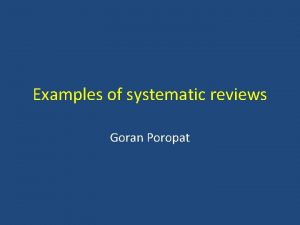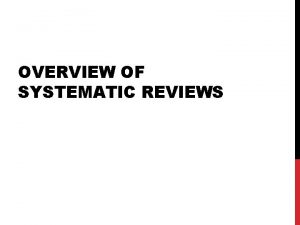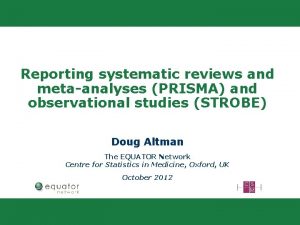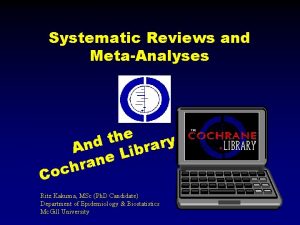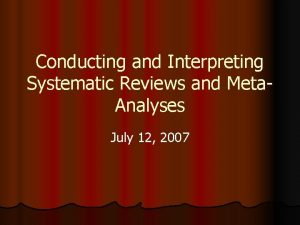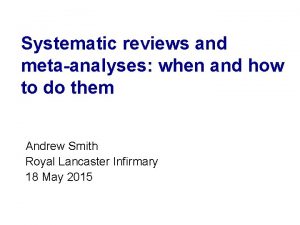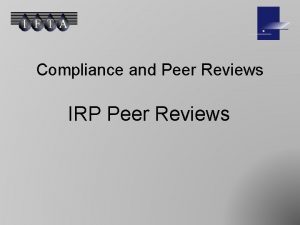INSTITUTE OF EDUCATION EPPIReviewer and Systematic Reviews Introductory






















































- Slides: 54

INSTITUTE OF EDUCATION EPPI-Reviewer and Systematic Reviews Introductory Workshop 16 June 2020 EPPI-Reviewer Support EPPISupport@ucl. ac. uk @EPPIReviewer

Workshop Learning Objectives To understand… q q q q q Systematic review process. How to access help both in and outside ER. Basic navigation of ER Web. Importing references. Managing duplicates. Adding and editing coding tools/codes. Screening. Data extraction. Generating reports. PRISMA diagrams. 2

Why Systematic Reviews? How to provide objective evidence to inform practice? § “Rather than looking at any study in isolation, we need to look at the body of evidence” (Nordenbo, 2009, p. 22) § Systematic review: "a review of research literature using systematic and explicit, accountable methods" (Gough, Oliver & Thomas, 2012, p. 2) Ø Transparent and explicit Ø Replicable and updatable Ø Identify gaps, contradictions or (in)consistencies 3

Aggregative v Configurative Aggregative reviews predominately add up (aggregate) findings of primary studies to answer a review question. Ø indicate the direction or size of the effect in a meta-analysis. Configurative reviews predominately arrange (configure) the findings of primary studies to answer the review question. Ø offer a meaningful picture of what research is telling us. 4

Systematic Review Process Ø Review question and conceptual framework Ø Search strategy: search string and selection criteria Ø Study screening q Title & Abstract Ø Study retrieval Ø Screen on full text Ø Data Extraction Ø Quality assessment Ø Synthesis Ø Report 5 Retrieved from Your. Health. Net: http: //navigatingeffectivetreatments. org. au/exploring_systematic_reviews. html (12 Feb, 2019)

Study Protocol Why are protocols important? Ø Discoverable Ø Transparent Ø Replicable Ø Reduce research bias Ø Reduce duplication and waste of resources 6

Study Protocol § Background o Gives context and provides a summary of PICO(TS). § Summary of existing literature o Overview of literature that is important to the review question. o End with a rationale why the question is important. § Research question and aims § Methods o Search strategy, screening & selecting, quality assessment, data extraction, data analysis. § Time frame 7

EPPI-Reviewer: What is it for? EPPI-Reviewer was created to support the methodological work conducted at the EPPI-Centre. This makes it a Research Tool in two distinct senses: 1. It enables the production of a range of reviews and analyses (secondary research). 2. Supports the development of Evidence Synthesis methodologies (research on research methods). EPPI-Reviewer helps by: Ø keeping your review process explicit and replicable Ø enabling you to defend your work Ø keeping your data in one place Ø allowing updates to your review 8

EPPI-Reviewer Gateway https: //eppi. ioe. ac. uk/cms/er 4 § Access latest information about ER and features § Support forums § User manual, FAQ § Instructional videos § Export to RIS facility § Access to the ER review and account manager 9

EPPI-Reviewer Instructional Videos § Accessed through EPPIReviewer gateway or our You. Tube channel. § Video playlists available for General, ER 4 and ER Web. § Variety of ER Web topics, including: Ø Importing references Ø Editing coding tools Ø Screening/coding Ø Running reports Ø Interactive EGM 10

EPPI-Reviewer Web – Home Screen § Click on the blue Help button to view contextual help. Feedback button is not for support requests – please email EPPISupport@ucl. ac. uk 11

Exporting references from Mendeley 1. Select the documents that you want to export from Mendeley. 2. Click on File and then Export. 3. Type in a file name and change the file type to RIS. 4. Save to your device. 12

Exporting references from Google Scholar 1. Ensure that you are logged into Google Scholar. 2. Conduct your search. 3. Click on the star at the bottom of an item to save it into your ‘My Library’. 4. Once you have saved the items to export, click on My Library at the top right. 5. Select the items you want to export from the list. 6. Click on the export button. 7. Choose Ref. Man. 8. Save to your device. 13

Importing references Review home tab Ø Click on the Import items button Ø The Import/Manage Sources page will be displayed. Ø Select an import filter. v RIS for Mendeley & Google Scholar Ø Find your file and click open. Video: https: //youtu. be/Emkuq 5 H_FB 0 14

Importing references Ø Number of items to import will be displayed. Ø Enter search details if desired, including string, database and date of the search. Ø Click on the Show Preview button to see items for importing. Ø Check to see if they appear as you would expect. Ø Click Hide Preview to collapse. Ø Click on Import to bring the items into your review. Video: https: //youtu. be/Emkuq 5 H_FB 0 15

Importing references from Pub. Med Ø Click on Pub. Med tab. Ø Type in your search terms. Ø Click Search Pub. Med and the items will be listed. Ø Preview items and set the number to import (not too many!) Ø Click Import to bring the items into your review. Video: https: //youtu. be/Emkuq 5 H_FB 0 16

Manually creating an item Ø Review home tab. Ø Click on the black arrow next to Import Items. Ø Click on New Reference. Ø Enter the citation details in the Edit Reference window. Ø Be sure to select the correct reference type (e. g. journal article). Ø When finished, click Save and Close. 17

Importing references § A list of sources in the review is also displayed. Ø Clicking on one will show you the source information. § Video: https: //youtu. be/Emkuq 5 H_FB 0 To return to the previous screen, click on Close/back in the top right-hand corner. 18

Managing duplicates – ER Web Clicking the Manage Duplicates button opens the Duplicates window. 19

Managing duplicates – ER Web To list duplicates after you have imported all items, click on Get new duplicates. Ø Items will be grouped with similar references, with groups displayed on the left (completed groups are marked in green). Ø Each item in the group is assigned a similarity score, compared to a Master item. 20

Managing duplicates – ER Web Mark Automatically will mark all items that have a similarity score of 1. 00 as a duplicate. Complete groups are checked off. Ø Incomplete groups will highlight any differences. Ø User must mark items as A duplicate, Not a duplicate or Mark as Master. 21

Your next steps 1. Set up your screening coding tool. 2. Screen all items on title and abstract, using include/exclude criteria. 3. Locate and upload PDFs of any items marked as INCLUDE on title & abstract. 4. Screen the items again, reading the full text. 5. Set up your data extraction coding tool. 6. Extract data from the included items. 7. Run reports to be able to analyse your data. 22

Screening § Screening uses your review inclusion and exclusion criteria. § Screening occurs in two stages and require separate coding tools: Ø Screening on title and abstract. Ø Screening on full text. § Important to be over-inclusive initially, then apply criteria more strictly to full papers. 23

Coding Tool Types Screening tools § Displayed in green. § Allow 2 types of codes: Ø Include Ø Exclude § Allows include v exclude comparisons. § Can be in normal or comparison (double coding) data entry mode. Comparison mode Normal mode § Can only have one level of hierarchy. Ø Enables easier production of frequency reports and reconciliation. 24

Importing coding tools 1. Click on Import Coding Tool(s). 2. Choose the type of coding tool from the list. 3. Click on Proceed. 25

Importing public coding tools 1. Choose a coding tool. 2. Preview it. 3. Click on Import Selected. Ø You may need to scroll down to find it. 26

Creating coding tools Video: https: //youtu. be/b. GTyqe_y. Sy. A 1. Either click on Coding Tools or Edit Tools. 2. Click on Add Coding Tool. 3. Select the tool type and give the coding tool a name. 4. Select Normal or Comparison (double) coding. 5. Click Create. 27

Creating child codes Video: https: //youtu. be/b. GTyqe_y. Sy. A 1. Select a coding tool or code in the panel on the right. 2. Click on Add Child. 3. Select Code Type, type in a code name and a description. 4. Click Create. 28

Your next steps 1. Set up your screening coding tool. 2. Screen all items on title and abstract, using include/exclude criteria. 3. Locate and upload PDFs of any items marked as INCLUDE on title & abstract. 4. Screen the items again, reading the full text. 5. Set up your data extraction coding tool. 6. Extract data from the included items. 7. Run reports to be able to analyse your data. 29

References Tab 1. Click on View Options to customise your item view. 2. Change the Page size number, to change the number of items displayed on the page. 3. Click on GO next to an item to view that record. 30

Screening items – ER Web The EPPI-Reviewer Web Item Details interface. Coding tool Info box Navigation Abstract Title Auto Advance To edit an item record, you must click on the Edit button 31

Screening items – ER Web Customise phrases Add terms or change the style Show relevant and irrelevant terms Find PDF 32

Viewing coding record – ER Web To see what you have coded at any time, click on Coding record and then View. Ø Keeps a thorough record of every coding decision made by all review members. 33

Your next steps 1. Set up your screening coding tool. 2. Screen all items on title and abstract, using include/exclude criteria. 3. Locate and upload PDFs of any items marked as INCLUDE on title & abstract. 4. Screen the items again, reading the full text. 5. Set up your data extraction coding tool. 6. Extract data from the included items. 7. Run reports to be able to analyse your data. 34

Frequency Report – ER Web In the Frequencies tab, select the coding tool or parent code, click Set and then Get frequencies. Ø Frequencies are only retrieved for one level of hierarchy. Ø Clicking a blue number in the Count column will list those items. 35

Include, Exclude, Delete flags – ER Web All items imported into a review are automatically marked as included. Ø Marking items as Include (I flag), Exclude (E) or Deleted (D), can help organise your review. Ø You can list items by clicking on the I, E or D icons. To change an item‘s flag: 1. Select the item(s) 2. Click the In/Exclude button for changing to I or E. 3. Choose selected documents (or a specific code), change Assign as to Included or Excluded and click Assign. 4. To mark as D click the trash can icon. 36

Uploading PDFs Ø Click on Upload at the bottom of the item record. Ø Select the file you want to upload and click on Open. Ø Your file will now appear at the bottom of the item record, in the Documents panel. Ø To view the PDF, click on the green eye icon. Ø To delete the PDF, click on the red trash icon. 37

Your next steps 1. Set up your screening coding tool. 2. Screen all items on title and abstract, using include/exclude criteria. 3. Locate and upload PDFs of any items marked as INCLUDE on title & abstract. 4. Screen the items again, reading the full text. 5. Set up your data extraction coding tool. 6. Extract data from the included items. 7. Run reports to be able to analyse your data. 38

Your next steps 1. Set up your screening coding tool. 2. Screen all items on title and abstract, using include/exclude criteria. 3. Locate and upload PDFs of any items marked as INCLUDE on title & abstract. 4. Screen the items again, reading the full text. 5. Set up your data extraction coding tool. 6. Extract data from the included items. 7. Run reports to be able to analyse your data. 39

Data Extraction § After screening on full text § Detailed data on methods and results Ø § Produce a synthesis May include: Ø Information about study sample and study design Ø Inductive coding of qualitative text Ø Collecting outcome data for statistical meta-analysis Ø Study quality and relevance § Try to stick to 3 levels: Ø Section (e. g. Sample Description) Ø Question (e. g. Sample Focus) Ø Answer (e. g. Teachers) 40

Your next steps 1. Set up your screening coding tool. 2. Screen all items on title and abstract, using include/exclude criteria. 3. Locate and upload PDFs of any items marked as INCLUDE on title & abstract. 4. Screen the items again, reading the full text. 5. Set up your data extraction coding tool. 6. Extract data from the included items. 7. Run reports to be able to analyse your data. 41

Line by Line PDF Coding – ER Web Video: https: //youtu. be/9 e. P 70 M 4 a 9 i. E 1. Click on the green eye icon to display the PDF. 2. Highlight the text in the PDF you want to code. 3. Click on the code it should be assigned to. 4. Click on the Highlight button (Black with an A symbol). 42

Inductive Coding To add codes on the fly: 1. Click on the coding tool or parent code where you want to add the child code. 2. Click on the + icon. 3. Choose the code type. 4. Type in the code name. 5. Click on Create. 43

Your next steps 1. Set up your screening coding tool. 2. Screen all items on title and abstract, using include/exclude criteria. 3. Locate and upload PDFs of any items marked as INCLUDE on title & abstract. 4. Screen the items again, reading the full text. 5. Set up your data extraction coding tool. 6. Extract data from the included items. 7. Run reports to be able to analyse your data. 44

Searching ER Web 1. Click on New Search. 2. Choose how you want to search for your items. 3. Click on Run Search. Combine searches with boolean operators. You can also search for items with a specific code by selecting the code in the Codes panel, and clicking on With this Code. 45

Crosstab Report – ER Web Optional: filter by a specific code 1. Choose a parent code for the X-axis and the Y-axis by selecting the code in the Codes panel and clicking Set. 2. Click on Get Crosstabs. 46

Coding Reports Similar to a coding report in ER 4. 1. Select the items to include. 2. Click on Coding Report. 3. Choose which coding tools to include. 4. Click the checkbox next to JSON report? to create a JSON report for an EGM. 5. Click Get Report. 6. View/Print opens report tab. 7. Click the blue save icon to save as a HTML file. Video: https: //youtu. be/i. GXgpb 4 bw. Fg 47

Quick Question Reports – ER Web Similar to a configurable report in ER 4. 1. Select the items to include. 2. Click the black arrow next to Coding Report. 3. Click on Quick Question Report. 4. Choose the parent/question code from any coding tool. 5. Choose whether to include Info. Box text and line-by-line PDF coding. 6. Click Get Report. 7. View/Print opens report tab. 48

Quick Question Reports – ER Web Appears below after clicking on Get Report. Clicking View/Print will open it in a new tab. Save report as HTML and open in Excel or Word. 49

Diagram Report – ER 4 Can be used to create review flow diagrams (also called PRISMA diagrams) based on the coding you have done. 1. Click on the Diagrams tab. 2. Right click a codeset to insert all child codes into the diagram OR right click an individual code to insert it. 3. Change shapes. 4. Automatically add code counts. 5. Save diagram. 6. Export as PNG file. 50

Diagram Report – ER 4 51

Meta Analysis 52

Further Support § Things to keep in mind… 1. Without a plan, EPPI-Reviewer is ‘inert’. 2. The interface includes many functionalities (e. g. ‘with this code’, ‘assign’, ‘auto advance’, ‘highlights’, etc. ) Ø it takes time to explore it! 3. § If you need any help at all, we are here for you! Ø EPPISupport@ucl. ac. uk Ø Support forum: https: //eppi. ioe. ac. uk/cms/Default. aspx? tabid=2932 Ø FAQ: https: //eppi. ioe. ac. uk/cms/Default. aspx? tabid=3384 Ø You. Tube: https: //www. youtube. com/user/EPPIReviewer 4 Questions / comments?

References Boland, A. , Cherry, M. G. , & Dickson, R. (2017). Doing a systematic review: A student’s guide (2 nd edition). SAGE Publications. Bond, M. (2020). Facilitating student engagement through the flipped learning approach in K-12: A systematic review. Computers & Education, 103819. https: //doi. org/10. 1016/j. compedu. 2020. 103819 Collins, A. , Coughlin, D. , Miller, J. , & Kirk, S. (2015). The Production of Quick Scoping Review and Rapid Evidence Assessments: A How to Guide. Department for Environment, Food & Rural Affairs. https: //www. gov. uk/government/uploads/system/uploads/attachment_data/file/560521/Productio n_of_ quick_scoping_reviews_and_rapid_evidence_assessments. pdf Cook, D. A. , & Reed, D. A. (2015). Appraising the Quality of Medical Education Research Methods: The Medical Education Research Study Quality Instrument and the Newcastle–Ottawa Scale-Education. In: Academic Medicine, 90(8), 1067 -1076. Gough, D. , Oliver, S. , & Thomas, J. (Eds. ). (2012). An introduction to systematic reviews. London Thousand Oaks, Calif: SAGE. Newman, M. , & Gough, D. (2020). Systematic Reviews in Educational Research: Methodology, Perspectives and Application. In: Zawacki-Richter O. , Kerres M. , Bedenlier S. , Bond M. , Buntins K. (eds) Systematic Reviews in Educational Research. Springer VS, Wiesbaden. https: //doi. org/10. 1007/978 -3 -658 -27602 -7_1 Nordenbo, S. E. (2010). Evidence and synthesis: a new paradigm in educational research. In The Research Council of Norway (Ed. ), Rigour and relevance in educational research (pp. 21– 27). St. Hanshaugen, Norway: The Research Council of Norway Petticrew, M. , & Roberts, H. (2006). Systematic reviews in the social sciences: A practical guide. Malden, MA Oxford: Blackwell Pub. Van Alten, D. C. D. , Phielix, C. , Janssen, J. , & Kester, L. (2019). Effects of flipping the classroom on learning outcomes and satisfaction: A meta-analysis. Educational Research Review, 28, 100281. https: //doi. org/10. 1016/j. edurev. 2019. 05. 003
 Eppi reviewer
Eppi reviewer Prospero registry
Prospero registry Target institute of medical education and research
Target institute of medical education and research Judicial education institute of trinidad and tobago
Judicial education institute of trinidad and tobago 1-1 practice variables and expressions
1-1 practice variables and expressions Numerical expression
Numerical expression Conclusion formula
Conclusion formula Using therefore in middle of sentence
Using therefore in middle of sentence Comma after introductory phrase
Comma after introductory phrase Wonnacott and wonnacott introductory statistics pdf
Wonnacott and wonnacott introductory statistics pdf Introductory chemistry concepts and critical thinking
Introductory chemistry concepts and critical thinking Phrases signal example
Phrases signal example Uq eap
Uq eap Nj institute for continuing legal education
Nj institute for continuing legal education Tonga institute of higher education
Tonga institute of higher education Uga institute of higher education
Uga institute of higher education Purpose of introduction
Purpose of introduction Introductory phrases examples
Introductory phrases examples Counterargument
Counterargument News story example
News story example Intro paragraph format
Intro paragraph format Example of introductory paragraph with thesis statement
Example of introductory paragraph with thesis statement Adverb clause modifying an adverb examples
Adverb clause modifying an adverb examples Www.atlasti.com
Www.atlasti.com Introductory paragraph literary analysis
Introductory paragraph literary analysis Nominal and adverbial clauses
Nominal and adverbial clauses Example of an introduction paragraph
Example of an introduction paragraph Introductory chemistry 4th edition
Introductory chemistry 4th edition Introductory chemistry 5th edition nivaldo j. tro
Introductory chemistry 5th edition nivaldo j. tro Introductory chemistry 5th edition answers
Introductory chemistry 5th edition answers Onedrive uniovi
Onedrive uniovi Steps for an introduction paragraph
Steps for an introduction paragraph Commas after introductory elements
Commas after introductory elements Army traffic safety course
Army traffic safety course Anecdote introductory paragraph examples
Anecdote introductory paragraph examples Chapter 2 descriptive statistics answer key
Chapter 2 descriptive statistics answer key Introductory rite
Introductory rite Introductory paragraph hook strategies
Introductory paragraph hook strategies Introductory paragraph examples
Introductory paragraph examples Introductory adverb
Introductory adverb Comma introductory clause
Comma introductory clause Introductory paragraph examples high school
Introductory paragraph examples high school Form content and use
Form content and use Medaccred oven
Medaccred oven Importance of introductory paragraph
Importance of introductory paragraph Nivaldo j. tro introductory chemistry
Nivaldo j. tro introductory chemistry Introductory elements examples
Introductory elements examples Minimum wage essay outline
Minimum wage essay outline Basic essay and paragraph format
Basic essay and paragraph format Items in a series comma rule
Items in a series comma rule Introductory rites clipart
Introductory rites clipart Introductory clause
Introductory clause Advise reported speech
Advise reported speech Appositive verb
Appositive verb Nature of econometrics
Nature of econometrics
